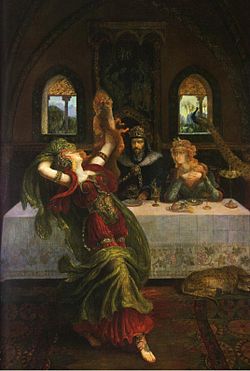Herod II
Herod II (ca. 27 BC – 33/34 AD)[1][2] was the son of Herod the Great and Mariamne II, the daughter of Simon Boethus the High Priest. For a brief period he was his father's heir. Some writers call him Herod Philip I (not to be confused with Philip the Tetrarch, whom some writers call Herod Philip II).
| Herod II | |
|---|---|
| Prince of Judea | |
 Dance Of the Seven Veils( A Painting depicting Herod II, Herodias and Salome) | |
| Born | c. 27 BC |
| Died | 33/34 AD |
| Spouse | Herodias |
| Dynasty | Herodian dynasty |
| Father | Herod the Great |
| Mother | Mariamne (third wife of Herod) |
Herod was the first husband of Herodias, and because the Gospel of Mark (Mark 6:17) states that Herodias was married to Philip, some scholars have argued that his name was actually Herod Philip. Because he was the grandson of the high priest Simon Boethus he is sometimes described as Herod Boethus, but there is no evidence he was actually called this.[3]
Life and marriage
Herod the Great's execution of his two sons born by his Hasmonean wife Mariamne, Alexander and Aristobulus IV in 7 BC, left the latter's daughter Herodias orphaned and a minor. Herod engaged her to Herod II, her half-uncle, and her connection to the Hasmonean bloodline supported her new husband's right to succeed his father.
As Josephus reports in Jewish Antiquities (Book XVIII, Chapter 5, 4):
Herodias, [...], was married to Herod, the son of Herod the Great by Mariamne, the daughter of Simon the High Priest. [Herod II and Herodias] had a daughter, Salome...[4]
This led to opposition to the marriage from Antipater II, Herod the Great's eldest son, and so Herod demoted Herod II to second in line to the succession. Antipater's execution in 4 BC for plotting to poison his father seemed to leave Herod II, now the eldest surviving son of Herod the Great, as first in line, but his mother's knowledge of the poison plot, and failure to stop it, led to his being dropped from this position in Herod I's will just days before he died. Herod II lived in Rome with Herodias as a private citizen[5] and therefore survived his father's deathbed purges. Herod Antipas and his other remaining half-brothers shared Judaea amongst them.
Divorce
Herodias later married Herod II's half-brother, Herod Antipas. According to Josephus:
Herodias took upon her to confound the laws of our country, and divorced herself from her husband while he was alive, and was married to Herod Antipas[4]
According to the Gospel of Matthew[6] and the Gospel of Luke,[7] it was this proposed marriage that John the Baptist opposed. The Gospel of Matthew indicates that John was executed because he criticized this marriage.[8] Nothing is known of Herod II after his divorce.
Notes
- Kokkinos (1999), The Herodian Dynasty, p. 237
- Nelson, Thomas (1996) Nelson's Complete Book of Bible Maps and Charts p. 290
- Florence Morgan Gillman, Herodias: at home in that fox's den (Liturgical Press, 2003) p. 16.
- W. Whiston translation at Project Gutenberg
- Merrill Chapin Tenney, Walter M. Dunnett, (1985). New Testament Survey, Wm. B. Eerdmans Publishing
- Matthew 14:3–5
- Luke 3:18–20
- Matt 14:3–12
References
- Kokkinos, Nikkos (1998). The Herodian Dynasty: Origins, Role in Society and Eclipse. Journal for the Study of the Pseudepigrapha Supplement Series. Sheffield: Sheffield Academic Press. pp. 236–240. ISBN 978-1-85075-690-3.